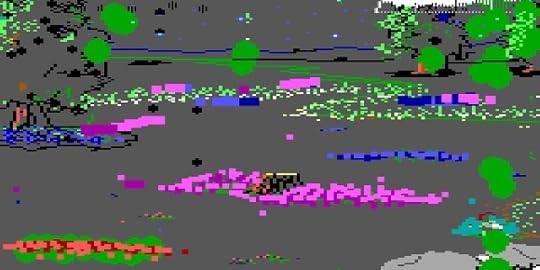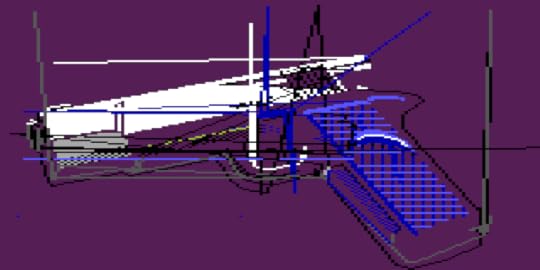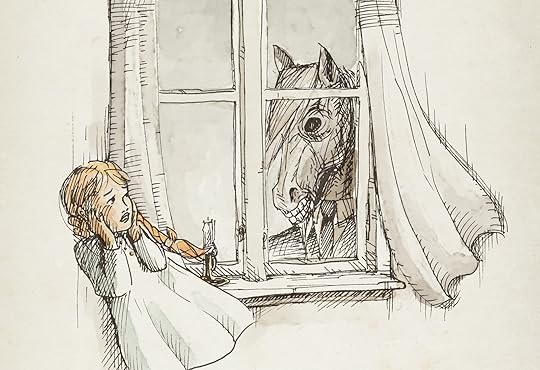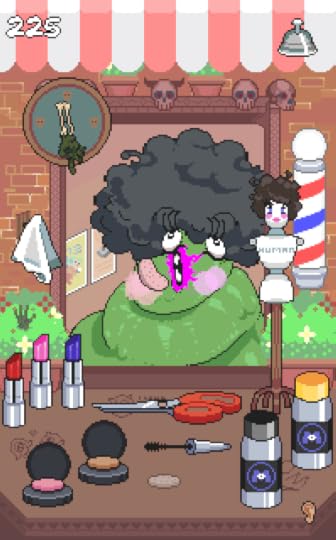Kill Screen Magazine's Blog, page 231
September 3, 2015
A Twitter bot turns old Sierra games into beautiful glitches
There's a narrator who routinely mutters random, bewildering sentences to Adam Mathes on his Twitter feed. He's fine with it. He put the narrator there himself. It's actually somewhat of a comfort.
This narrator exists under the Twitter handle @quest_ebooks but started out life in Sierra Entertainment's many classic adventure games. Mathes grew up playing those adventure games, he loved them, and so he wanted to bring their "omniscient, antagonistic, baffling" narrators through his life with him. This is why he created a Twitter bot for them to exist within.
Mathes was inspired by Andrew Vestal's “YouAreCarrying” bot. That one tweets out item lists based on various inventory from Infocom games. Wanting to recreate a similar bot, but one concerned with Sierra games, Mathes took to figuring out how to make it work. "The hard work here was done by others long before me," Mathes says, "Sierra in creating games, a community of fans who created tools to disassemble Sierra games, understand the formats and engines, and create new ones using the same engine, and people who created frameworks to easily create 'ebooks'-style Twitter bots."

With these frameworks already in place, all Mathes found that he needed to do was connect the dots. He customized a bot created by Jaiden Mispy to extract the text from early Sierra games and then generate similar Tweets using statistical models Mathes had constructed for it (if you want to know more about the technical side of this then check out this post).
"simulating if the original bits had rotted away"
But Mathes didn't stop there. Creating that led to a discovery which, in turn, had him creating yet another bot using Sierra games as a basis once again. While working on @quest_ebooks, Mathes was surprised to find that the background pictures in early Sierra games weren’t stored the way he had expected. He explained that later Sierra games were bitmaps—"a straight forward mapping of pixel colors to a specific position"—but the early ones used a vector format instead. According to Mathes, this means that they are built using a series of commands. They worked like this: "draw this line, change color, draw this circle, change color, fill this region starting here with this pattern, draw a rectangle, etc."
Using the vector format makes the background images much more compact. This would have been useful for squeezing the game's data onto older computers (from the 1980s onwards) so it makes sense that Sierra would have used this method. For Mathes, though, it opened up his mind to the idea of trying to "glitch these things out based on understanding that data format."

First, he found the source code to old DOS utilities by Lance Ewing. These display the images and update them to work in a modern OS X environment and output PNG images. Then Mathes had to experiment with the drawing commands of the images to try to produce interesting results. He shuffled the commands and randomly generated new ones but no significant or eye-catching results were produced.
"Eventually, I wrote some straightforward code in C to glitch out the underlying picture files, simulating if the original bits had rotted away or changed in some way, then generated the PNG from that corrupted data," Mathes said. With a little bit of tweaking, he got what he was after, and this is what his Twitter bot @quest_glitches now regularly shares.
endlessly remix the games of his childhood
As with all glitches, the quality of each of the corrupted background images is subjective, but the best ones tend to be the more abstract or messy ones. You get some in which the source image is easily recognizable, it looking like a toddler has scribbled over a Microsoft Paint drawing with different colors, leading to a rather underwhelming finish. The ones that work really well are those with only one or two objects displayed on a single background color. With these, the corruption is able to completely transform whatever was once in the image into something completely different.

For Mathes, the existence of this bot, as well as the narrator-based one, is enough. He says that, for him, "there's some sense that with these generative programs, simple and primitive as they are, there’s this little bit of illusion of infinity and immortality to these things we loved." His bots endlessly remix the games of his childhood in new ways, reigniting his interest in them over and over.
You can follow @quest_ebooks and @quest_glitches on Twitter. For more of Adam Mathes's work check out his website.
UCLA and Kinect just made sandboxes so much cooler
When I was a kid, I had a small plastic sandbox on my patio in the shape of a turtle. It came with a little turtle shell cover to keep the sand clean and safe when I wasn’t playing with it, but looking back on it as an adult, that stuff still probably wasn’t all that sanitary. Still, it was always one of my favorite things to play with as a child, even if it annoyed my parents, and I’m guessing I wasn’t alone in that. It could never quite replace the joy I got from videogames, but sometimes you just need to reach out and, you know, actually touch something.
use a gesture to drop rain on the world
With all that in mind, UCLA’s newest teaching tool manages to combine both the spectacle of videogames with the pure physical fun of sandboxes in an experience that would have had my child self practically praying to Santa for it. Dubbed the "Augmented Reality Sandbox," the premise is really quite simple—take a sandbox, mount a Kinect over it, and use the Kinect to track the movements of the sand in real-time and overlay projected graphics onto it.
The result is a series of hills, valleys, and even lakes that you can manipulate to your heart’s content just by shifting the sand around. It almost reminds me a little bit of From Dust, but with the added benefit of physical interaction and, well, playing with sand. You can even use a gesture to drop rain on the world, adding to the water projected on the sandbox and fulfilling all your nightclub dreams of “making it rain.”
The idea is to use the Augmented Reality Sandbox to simulate geological concepts in the classroom and thus help college students more easily understand the lay of the land. That said, maybe if I’m extra good this year, Santa will be kind enough to bring me a home version? Pretty please?
Mario Maker: The Platformer Platform
Mario Maker feels less like a Kyoto product than a Silicon Valley one
Unsolicited shows us the begrudging lives behind junk mail
Sign up to receive each week's Playlist e-mail here!
Also check out our full, interactive Playlist section.
Unsolicited (PC, Mac, Linux)
BY Lucas Pope
Given the vacuity of the junk mail that mailboxes regularly puke onto entrance mats, you'd be forgiven to think there wasn't a single soul behind it. In one respect, you're right, as the souls of the people who are paid to produce junk mail probably died a long time ago. Such is the nature of the job. This is something you'll discover as you play Lucas Pope's latest game, Unsolicited. Similar to Pope's celebrated solo debut Papers, Please, Unsolicited has you sorting through and filling out documents for an unforgiving authority. This time, instead of serving a post-war Eastern European state, it's an American company that pays you. Communist evils are swapped for capitalist evils. The result is more or less the same: you suffer while trying to keep up with the demands of increasingly complex paperwork, and you're forced to drag the misery of others along with you.
Perfect for: Junk mail sufferers, data entry deputies, fans of Papers Please
Playtime: Half an hour

The ruthless capitalism of Wario Land: Super Mario Land 3
How Nintendo slipped a critique of Western values into its mega-hit series
Simogo channels its Swedish folk-horror into a scary children's book
Eerie adventure game Year Walk is headed to the Wii U, but rather than celebrate with a spin-off, or DLC, or other things game companies like to put out before a new release, Simogo has published an eBook called Year Walk Bedtime Stories for Awful Children to mark the occasion.
Bedtime Stories for Awful Children is a collection of five gruesome short stories inspired by both the folk tales of Simogo’s native Sweden and the creatures that haunt Year Walk. With the gloom of Edward Gorey and art by Johanna Meijer, the Year Walk storybook includes such charming tales as: a girl exploding into water after seeing a horse man, a young pervert turning into a tree, and more!

They’ve also been translated into English, French, Spanish, German, and Italian because, as Simogo says, "we think obnoxious children all over the world deserve dark nightmares."
You can download the Year Walk storybook as a free PDF on Simogo’s website.
Forget Mario. Let���s talk about Peach.
Mario and Peach’s relationship is #complicated.
September 2, 2015
A videogame adaptation of Hamlet has been turned back into a stage show
To be, or not to be—that is a rhetorical question, and it gets at the challenges facing anyone who wishes to convert Shakespeare's Hamlet into a videogame. Games are about the ways user choices can shape a narrative and Hamlet—well, let's just say he prefers to keep his own counsel.
Every level must be conquered until Hamlet's father's death has been avenged!
Nevertheless, Simon Peacock, the Voice and Motion Capture Director of Deus Ex: Mankind Divided, recently took on the challenge of converting Hamlet into a videogame, and then converting that game back into a play. This is more than a theatrical game of broken telephone: Hamlet: The Video Game (The Stage Show) mixes mediums in order to highlight their unique narrative properties. The audience at the show's performance fulfills the role of a game's focus group, both commenting on and shaping the game that is taking place on stage. As the webpage for the show's debut performance in New Zealand puts it: "every level must be conquered until his (Hamlet's) father's death has been avenged!"
In an excellent radio interview about his game-cum-show (let's just agree to call it a production?), Peacock conceded that Hamlet is "the worst show Shakespeare wrote to turn into a videogame because it's four hours of dialogue and five minutes of action." Yet this incompatibility is what makes Hamlet: The Video Game (The Stage Show) compelling. At the point where you're finally adding a final boss battle to Shakespeare, you might as well go all the way. Moreover, taking on one of Shakespeare's most popular plays allows Peacock to highlight the ways in which videogames have been evolving as a narrative form. "I wanted to make something that was accessible to theatregoers as well as videogamers," Peacock explained in his radio interview, "so we had to find some common ground."
Of course, convergence with traditional theatre is unlikely, but it is also unnecessary. Radically different adaptations offer audiences an opportunity to see famous works in entirely new lights. Hamlet: The Video Game (The Stage Show) is simply taking the long-accepted premise that a story can be adapted in a great many ways to its quasi-logical conclusion. Once we accept that Shakespeare does not have to be treated with kid's gloves, we might as well let creatives from other disciplines, including videogame design, get in on the fun.
The transgressive politics of a monster dress-up game
You know who I've always admired? Divine. She was only a stage persona, a high-camp drag queen and music act, but one that challenged notions of beauty and decency while entertaining the hell out of you. I first came across Divine in John Waters's cult classic midnight movie Pink Flamingos (you may know her from Hairspray). In it, she is called "the filthiest person alive" by the newspapers, and it's a title that she desperately tries to uphold with her "filth politics."
In the film, she's considered to be a monster, or at least a criminal, but you can't help but be drawn towards Divine due to her confidence in voice and body. Even when she's gagging on actual dog shit at the film's notorious ending—at which point you've seen her hack up bodies, give head to her son, and advocate cannibalism—Divine is still somehow irresistible. She's known for her ugliness but specifically in how she transgresses it: she mimics the behavior of red carpet actresses of the '50s (Monroe and Mansfield especially), challenging their femininity by fitting her own pot-bellied 320 pound body into tight glamorous dresses, wearing big frightfully blonde hair, and licking her red glossy lips hungrily. She's filth's biggest star and she's absolutely rockin' it.
they embody that same resilience seen in Divine.
Divine is what I see in every single monster that you slap lippy on in the dress-up game Monstre de Coiffure. It was made for Ludum Dare 33, meaning that it's a riff on the game jam's theme of "You Are The Monster." In this case, you are the monsters' hairdresser, and must attempt to dolly them up to pass off as humans.
Unlike most other dress-up games, you're given both a specific look for each monster (demonstrated by a mannequin) and a time-limit in which to achieve it in. This is made all the more pressing by the fact that some of the monsters have abnormal portraits, as you might expect. It might be two heads (requiring double the amount of work) or a face so stretched and mutated that just finding the cheeks to apply blush to is half the challenge.

On top of that, the game's creators have put the care in to make each of your cosmetic tools tactile. Hair dye must be shaken before sprayed, scissors require several clicks to cut hair, and mascara has to be dragged up the screen to lengthen those lashes. You need to exert physical effort to succeed here, which makes it feel even more absurd that the finished result is always spectacularly non-human. You end up with slugs in wigs and torsos with teeth outlined clumsily with lipstick. These monsters never had a chance of being 'beautiful' as we're led to understand it (and as represented in the mannequin).
But these monsters refuse to have beauty denied to them and, with your help, squash their way into its spectrum. And it's in this that they embody that same resilience seen in Divine. In an essay on the transgressive politics of Divine, Lindsay Hallam noted how she became a grotesque icon for people at the fringes of society from the 1960s onwards. "In the past the freak lived in the carnival, a transient existence that put him/her on the fringes of society," Hallam writes. "The freak was marked as an outsider by both his/her appearance and lifestyle. In the 1960s, however, those who were anti-establishment began to identify themselves with the freak, as they too were persecuted because of their looks (long hair, strange clothes, androgyny), and situated themselves apart from mainstream society."
these monsters directly confront notions of beauty through their appearance
The monsters in Monstre de Coiffeure are the modern reincarnation of this bodily rebellion. We now have Instagram and Facebook encouraging people to post images of themselves, and due to it being up for judgement by hundreds or thousands, if not more, the pressure is to look beautiful or be harassed. A recent viral "challenge" attempted to subvert this reality but ended up failing spectacularly over time. The "Don't Judge Challenge" had people making themselves look as unsightly as possible in the first half of a video, and then, after a transition marked by their hand covering up the screen, would reveal themselves in as pristine condition as possible. The message was supposed to be "don't judge a book by its cover" applied to people, but ended up as a way for good-looking people to show off while simultaneously reinforcing the idea that ugly people are undesirable and should be laughed at.

Dressing up the monsters in Monstre de Coiffure is much closer to the attitude upon which the Don't Judge Challenge was founded and has little chance of being diverted to other means. By applying these cosmetic products, we see these monsters directly confront notions of beauty through their ghastly appearance, just as Divine did with her big shit-eating grin. This is taken further once the make-over is finished as each monster is then wheeled out to immediately face the judgement of the public. You ring a bell and, as they disappear off-screen, can hear them usually being greeted with screams, presumably from the humans that first catch sight of them.
You don't get to see the monsters' reaction to their bringing about horror to people but I hope that they flaunt their stuff even harder, smeared lipstick and all. That's what Divine would do. And she'd do it exactly because it's what we're told not to do, whether implicitly or directly, society pressuring the ugly, the freaks, to save themselves from potential humiliation. And it's in how they so aggressively subvert this expectation that we can admire these luscious queens of filth.
The terrifying comedy of Mario glitches
A conversation with the main who distorts and defiles your favorite childhood game.
Kill Screen Magazine's Blog
- Kill Screen Magazine's profile
- 4 followers



